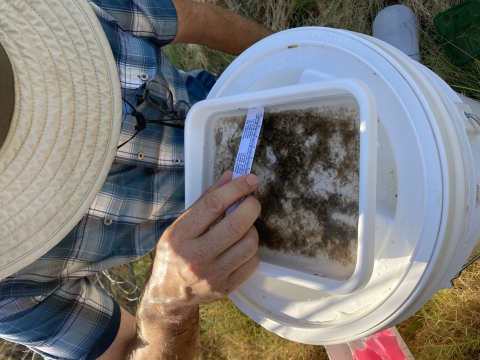What We Do
The National Wildlife Refuge System is a series of lands and waters owned and managed by the U.S. Fish and Wildlife Service. Wildlife conservation is at the heart of the refuge system. It drives everything we do from the purpose a refuge is established, to the recreational activities offered there, to the resource management tools we use. Selecting the right tools helps us ensure the survival of local plants and animals and helps fulfill the purpose of the refuge.
Refuges use a wide range of land management tools based on the best science available. Some refuges use prescribed fires to mimic natural fires that would have cleared old vegetation from the land helping native plants regenerate and local wildlife to thrive. Other refuges contain Wilderness areas where land is largely managed passively. The management tools used are aimed at ensuring a balanced conservation approach where both wildlife and people will benefit. At this field station our conservation toolbox includes: restoration, endemic species protection, invasive species invasive species
An invasive species is any plant or animal that has spread or been introduced into a new area where they are, or could, cause harm to the environment, economy, or human, animal, or plant health. Their unwelcome presence can destroy ecosystems and cost millions of dollars.
Learn more about invasive species removal, seed collection and storage, and research.
Management and Conservation
Resource Management
To help plants and wildlife, refuge staff use a variety of habitat management techniques to maintain, recover or enhance plant and wildlife. Careful consideration is given to various land, water, wildlife and restoration management plans in varying degrees according to the situation.
Plans and implementation is monitored and controlled to foster desired plant growth and to properly manage habitat for wildlife. Sometimes, sensitive areas are closed to the public so that the land or species can recover more quickly. Prescribed burning, mowing, re-vegetation and seeding are also some of the techniques used to help native plants recover on national wildlife refuges.
Surveys are conducted to evaluate how effective plans met habitat and wildlife use objectives.
Conservation
Refuge Planning
National Wildlife Refuge planning sets the broad vision for refuge management and the goals, objectives, strategies, and actions required to achieve it. Planning ensures that each refuge meets its individual purposes, contributes to the Refuge System’s mission and priorities, is consistent with other applicable laws and policies, and enhances conservation benefits beyond refuge boundaries.
Comprehensive Conservation Plans
Comprehensive Conservation Plans (CCPs) are the primary planning documents for National Wildlife Refuges. As outlined in the National Wildlife Refuge System Administration Act, as amended, the U.S. Fish and Wildlife Service (Service) is required to develop CCPs that guide refuge management for the next 15 years. CCPs articulate the Service’s contributions to meeting refuge purposes and the National Wildlife Refuge System mission. CCPs serve as a bridge between broad, landscape-level plans developed by other agencies and stakeholders and the more detailed step-downs that stem from Refuge CCPs.
The 2009 Final Comprehensive Conservation Plan for Desert, Ash Meadows, Moapa Valley, and Pahranagat National Wildlife Refuges can be found here: https://ecos.fws.gov/ServCat/Reference/Profile/7305
Step-down Plans
CCP step-down plans guide refuge-level programs for: (1) conserving natural resources (e.g., fish, wildlife, plants, and the ecosystems they depend on for habitat); (2) stewarding other special values of the refuge (e.g., cultural or archeological resources, wilderness, wild and scenic rivers, etc.); and (3) engaging visitors and the community in conservation, including providing opportunities for wildlife-dependent recreation. Like CCPs, step-down plans contribute to the implementation of relevant landscape plans by developing SMART (Specific, Measurable, Achievable, Relevant, and Time-bound) objectives, strategies, implementation schedules, and decision support tools to fulfill refuge visions and goals. This ensures that refuges are managed in a landscape context and that conservation benefits extend beyond refuge boundaries.
Law Enforcement
U.S. Fish and Wildlife Service law enforcement officers have a wide variety of duties and responsibilities. Officers help visitors understand and obey wildlife protection laws. They work closely with state and local government offices to enforce federal, state and refuge hunting regulations that protect migratory birds and other game species from illegal take and preserve legitimate hunting opportunities. Some other duties include patrolling closed areas or Wilderness areas, maintaining relationships with neighboring landowners, maintaining refuge boundaries, and participating in public events related to refuge issues.
Laws and Regulations
U.S. Fish and Wildlife Service law enforcement officers have a wide variety of duties and responsibilities. They enforce federal, state and refuge hunting regulations that protect migratory birds and other game species from illegal take and preserve legitimate hunting opportunities. Officers help visitors understand and obey wildlife protection laws. By fostering understanding and instilling in the visiting public an appreciation of refuge resources, laws, and regulations, our law enforcement encourages voluntary compliance through education, outreach, and law enforcement actions while in a welcoming and safe environment. Refuge law enforcement works collaboratively with law enforcement officers from other federal land management agencies, forming the Southern Nevada Agency Partnership (SNAP) Law Enforcement Team.
Law enforcement issues should be referred to the refuge manager.
You may also report violations to 1-844-FWS-TIPS (397-8477).




